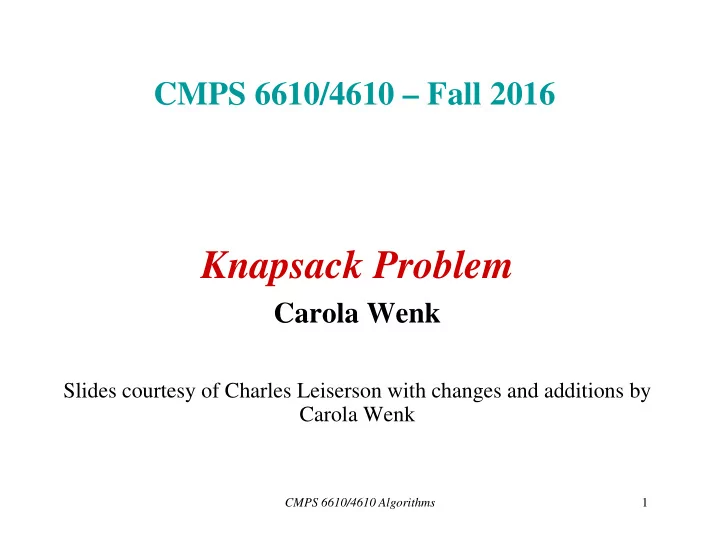

CMPS 6610/4610 – Fall 2016 Knapsack Problem Carola Wenk Slides courtesy of Charles Leiserson with changes and additions by Carola Wenk CMPS 6610/4610 Algorithms 1
Knapsack Problem • Given a knapsack with weight capacity , and given items of positive integer weights � � and positive integer values � � . (So, item has value � and weight � .) • 0-1 Knapsack Problem: Compute a subset of items that maximize the total value (sum), and they all fit into the knapsack (total weight at most W). • Fractional Knapsack Problem: Same as before but we are allowed to take fractions of items ( gold dust). CMPS 6610/4610 Algorithms 2
Greedy Knapsack • Greedy Strategy: � � – Compute � � for each – Greedily take as much as possible of the item with the highest value/weight. Then repeat/recurse. Sort items by value/weight runtime CMPS 6610/4610 Algorithms 3
Knapsack Example item 1 2 3 value 12 15 4 W=4 weight 2 3 1 value/weight 6 5 4 • Greedy fractional: Take item 1 and 2/3 of item 2 weight=4, value=12+2/3 15 = 12+10 = 22 • Greedy 0-1: Take item 1 and then item 3 weight = 1+2=3, value=12+4=16 • Optimal 0-1: Take items 2 and 3, value =19 CMPS 6610/4610 Algorithms 4
Optimal Substructure • Let � � be an optimal solution, where � = amount of item that is taken; � • Suppose we remove one item. items left • Is the remaining “solution” still an optimal solution for items? • Yes; cut-and-paste. CMPS 6610/4610 Algorithms 5
Correctness Proof for Greedy • Suppose items are numbered in decreasing order by value/weight. ∗ -1 and a • Greedy solution G: Takes all elements fraction of ∗ . • Assume optimal solution S is different from G. Assume S takes � ∗ -1. only a fraction � of item , for • Create new solution S’ from S by taking weight � away from items , and add of item back in. � Hence, all of item is taken. New solution S’ has the same weight but increased value. This contradicts the assumption that S was optimal. S=G. CMPS 6610/4610 Algorithms 6
General Solution: DP • = max value possible for taking a subset of items with knapsack constraint . • for all and for � � don’t take item i take item i • Compute by filling an DP-table. Two nested for-loops, runtime and space • Trace back from by redoing computation or following arrows. runtime CMPS 6610/4610 Algorithms 7
Solution: DP Example Take items 3 and 2 w W=4 4 0 12 15 19 W= item 1 2 3 3 0 12 15 16 value 12 15 4 2 0 12 12 12 weight 2 3 1 1 0 0 0 4 value/weight 6 5 4 0 0 0 0 0 i 0 1 2 3 Take item i: n Don’t take item i: don’t take item i take item i CMPS 6610/4610 Algorithms 8
Recommend
More recommend